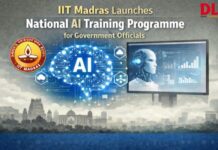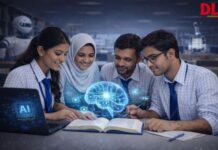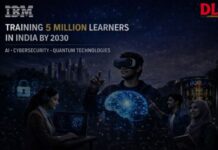What is the most pressing educational challenge India is facing?
The current challenge to education in our country is three fold that of access, equity and quality. At the level of secondary schooling, only about 40% of the children with the age group of 14 to 18 are in school. Access to secondary education is not available everywhere in the country; there are still pockets and long distances that need to be covered. Secondly, every section of society needs to be equally represented in the educational system, where they participate equally- this is still not addressed in India. The isadvantaged sections also need to be brought into the education sphere. The enrollment rates of girls are much lower than the boys and physically disabled section is also not represented well.
Then of course quality of education is a major challenge, which needs to be addressed on a priority basis. All the three aspects are interlinked.
If there is no quality then parents will feel discouraged to send their children to schools. So when they feel that after this much education, their children are not well qualified to enter in a job market, they would rather send their children to the job market without education. That is why quality is important. If quality is good then of course participation rate will improve.
How have we progressed in last 10 years?
We have progressed to a large extent. More students are in schools in numbers and also in terms of percentage. But it is not satisfactory. We need to insure this at the very first stage that everybody from standard one to eight aged six to thirteen should be in school. Actually it is desirable to extend it till the age of 16 so that from class 1 to 10 they have skills to enter in the job market. Now the challenge is to bring it to a kind of satisfactory level. At first stage we are hoping that by 2010 most of the children up to 14 years age are in the school and after that we have to concentrate on secondary stage.
The status of the teaching profession has plummeted in all regions of the world. What are the current measures the ministry has undertaken to keep this fraternity motivated and to build their capacity as well?
This itself is a societal problem and it is not only seen in India, but is a problem for several other countries of the world too. This is because of salary differentials in between this sector and the private sector. Right now the economy is in boom and there are alternate employment opportunities available; hence we do not see many people in the teaching profession. But at the same time there are people who are interested in teaching. The motivation has to come from society, appreciating the decision of person who chooses to teach and adopt this profession that helps the next generation. There is also a need for the teachers to continuously upgrade their skill through training programme and our responsibility is to give them other facilities and amenities that helps them in teaching. So, ICTs can provide an opportunity for the teachers to upgrade their skills.
Information and Communication Technologies are supporting many of the recent gains in education worldwide. Do you believe in the context of India, ICTs have any real potential to transform education?
There is a tremendous role for ICT in education everywhere and India is no exception. The problem in India is that when we talk of ICT infrastructure we find schools do not have a room for computers and many schools do not have electricity, telephone connections, etc. However all this will not only be possible but will be essential in few years from now because we have to adopt technology to keep up with time and without ICT we will be left behind. So it is not to choose between ICT and no ICT but to equip ourselves such that we make the best use this technology in education.
What initiatives has your department taken to integrate ICT in schools (in secondary education)?
We have from time to time started different initiatives, there was a class programme earlier and there was a satellite and computer literacy programme, now we have reformulated the scheme called ‘ICT in schools’ where we give assistance to the centrally sponsored schools and government aided schools which are equipped with infrastructure and the learning material. In this scheme, one, we focus on teaching computers to children and second, use computers as an aid in teaching and also for self-learning. Now the results have started coming, but in a small way. About 500 schools in a year are able to access this scheme, and we have a long way to go. We have about 100000 secondary schools in government and government aided sectors and we have to scale it up so that all schools can avail this facility.
Ideally every school from standard one to twelve should have adequate numbers of computers but because of resource constraints we had failed to prioritise this. Now we have one programme for secondary and higher secondary schools, which is the ‘ICT in schools’ programme, where we feel that computers can be used in a big way. It provides an aid in teaching particularly hard subjects such as science, languages and mathematics. Through animation, science and geography can be made more interesting, that is why ‘ICT in schools’ programmes has been started. At the same time we also understand the implication of teaching children in schools. The secondary schools are easier to manage because there are 146 thousands schools in the government and government aided sector where as primary school it is even larger numbers. Since ideally we should cover all the schools, several elementary schools are also being targeted under the Sarva Shiksha Abhiayan (SSA), are being assisted with computers. Over a period of time we have to look at the pupil-teacher ratio in availability of computers.
Under this scheme, is there any central learning content that is being prepared or is the learning content being initiated at state level?
Under this programme we have asked the state governments to make use of funding to develop the content or procure already developed content. Generally in states, contents are generated in SCERT (State Council for Educational Research and Training), but it varies from state to state. We have not emphasized that there is only one kind of content that could be taught in schools and some flexibility has been given to the states to innovate. Otherwise there will be no innovation at all. We are looking at the process where some model content can be developed but we do not want uniform content all across the country, because content should be area specific and hence the state governments will be encouraged to take the initiative in this regard.
Several states have made good progress in creating content through some parallel schemes, which are run by state governments, for example, Government of Karnataka Rajasthan and Uttaranchal. They have developed good content and most of them in their local languages, which is distributed among the schools. Sometimes school teachers themselves develop content which is helpful in teaching.
In this whole programme of ‘ICT i



















